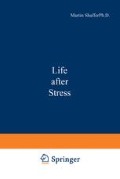Abstract
Understanding how to overcome stress on the job is important, but there is also another area of our lives in which stress often plays a crucial role. Indeed, for many the tensions and stresses produced within the family can be just as strong as, if not stronger than, those produced at work. In fact, family problems often spill over into the workplace, creating stressful situations that neither job pacing nor creation of a more positive atmosphere at work can overcome.
Access this chapter
Tax calculation will be finalised at checkout
Purchases are for personal use only
Preview
Unable to display preview. Download preview PDF.
References
Ackerman, N. W. Behavior trends and disturbances of the contemporary family. In I. Galdston (Ed.), The family in contemporary society. New York: International Universities Press, 1958.
Ackerman, N. W. The psychodynamics of family life. New York: Basic Books, 1958.
Backus, F., & Dudley, D. Observations of psychosocial factors and their relationship to organic disease. In Z. J. Kipowski, D. Lipsitt, and P. Whybrow (Eds.). Psychosomatic medicine. New York: Oxford, 1977.
Bateson, G., and Reusch, J. Communication: The social matrix of psychiatry. New York: Norton, 1951.
Berne, E. Transactional analysis. New York: Grove Press, 1961.
Corson, S., & Corson, E. Psychosocial influences on renal function: Implications for human pathophysiology. In L. Levi (Ed.), Society, stress and disease (Vol. 1). New York: Oxford University Press, 1971.
Froberg, J., Karlsson, C., Levi, L., & Lidberg, L. Physiological and biochemical stress reactions induced by psychosocial stimuli. In L. Levi (Ed.), Society, stress and disease (Vol. 1). New York: Oxford University Press, 1971.
Fromm, E. The art of loving. New York: Harper & Row, 1956.
Hall, E. T. The silent language. New York: Doubleday, 1959.
Henry, J. P., & Stephens, P. Stress, health and the social environment. New York: Springer, 1977.
Jackson, D., & Lederer, W. J. The mirages of marriage. New York: Norton, 1968.
Lecker, S. The natural way to stress control. New York: Grosset and Dunlap, 1978.
Pinneau, S. R., Jr. Effects of social support on occupational stresses and strains. Paper delivered at American Psychological Association Convention, Washington, D.C., September 1976.
Sarbin, T., & Coe, W. Hypnosis: A social psychological analysis of influence communication. New York: Holt, Rinehart & Winston, 1972.
Satir, V. Conjoint family therapy. Palo Alto, California: Science and Behavior Books, 1967.
Spiegel, J. P. Homeostatic mechanisms within the family. In I. Galdston (Ed.), The family in contemporary society. New York: International Universities Press, 1958.
Thomas, C. B., & Duszynski, K. R. Closeness to parents and the family constellation in a prospective study of five disease states: Suicide, mental illness, malignant tumors, hypertension and coronary heart disease. Johns Hopkins Medical Journal, 1974, 234, 251–269.
Watzlawick, P., Beavin, J., & Jackson, D. Pragmatics of human communication. New York: W. W. Norton, 1967.
Zuk, G., and Boszormenyi-Nagy, I. Family therapy and disturbed families. Palo Alto, California: Science and Behavior Books, 1967.
Rights and permissions
Copyright information
© 1982 Martin Shaffer
About this chapter
Cite this chapter
Shaffer, M. (1982). Stress Reduction in the Family. In: Life after Stress. Springer, Boston, MA. https://doi.org/10.1007/978-1-4684-4103-1_8
Download citation
DOI: https://doi.org/10.1007/978-1-4684-4103-1_8
Publisher Name: Springer, Boston, MA
Print ISBN: 978-1-4684-4105-5
Online ISBN: 978-1-4684-4103-1
eBook Packages: Springer Book Archive

